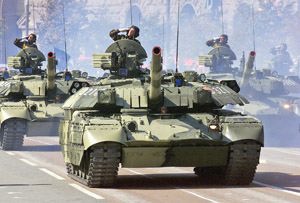Defense complex in danger
Three strategic and emblematic projects frozen due to lack of funding
Kyiv recently hosted the first national Forum of Ukraine’s Defense Industry. The event, at which more than 50 enterprises displayed their products, was intended to show that Ukraine still has a viable defense production complex (DPC), ready to work for the state’s defense capability and provide budget revenues. According to Volodymyr Hrek, chairman of the Ukrainian Defense Technologies association, the national defense industry is now prepared to put out products worth about 10 billion hryvnias. All it needs is adequate financial and administrative support from the state.
However, given the current situation, it is hard to be optimistic about Ukraine’s DPC. Funding for the armed forces and governmental orders for military technologies, has halved over the past three years. It has now reached what defense experts consider a dangerously low level of 570 million hryvnias a year. Moreover, Defense Minister Mykhailo Yezhel recently said that the 2010-12 budgets would only provide for keeping the army afloat, i.e., for satisfying the immediate needs of Ukraine’s Armed Forces. Upgrades and modernization may have to wait at least three years.
Defense industry-workers have leveled scathing criticism and indignation at this philosophy of DPC funding. Hrek is convinced that it does not comply with the president’s decrees: the State Program of Development of Ukraine’s Armed Forces, and the State Program of Armaments and Equipment Procurement.
The declaration of the so-called “triennial stabilization” of the Armed Forces also seems absurd. Indeed, as of today, the Ministry of Defense has incurred 1.2 billion hryvnias worth of debt towards defense contractors for unfinished projects. The latter includes the An-70 military cargo airplane, a corvette for the Ministry of Defense, and the Sapsan antimissile system. “The Malyshev plant now has a battalion of tanks to be upgraded to Bulat-type. The equipment has been delivered from the storehouse and is now being modernized. About 18 defense enterprises have invested funds to fulfill all state orders,” Hrek says, “but it appears that the state is not even planning to pay for its own order!”
The experts at the Center for Army, Conversion and Disarmament Studies estimate that, ideally, annual expenditures for DPC orders should be at least 500-700 million dollars. “Only five to seven years at this level can stop stagnation and make it possible to rearm and modernize the national army,” the center director Valentyn Badrak says. If we delay reform and proper funding for at least three years, the state will be forced to purchase arms abroad.
To maintain the national DPC at least at its current level, experts suggest that parliament pass top-priority defense programs and grant them national status, so they can be funded from outside the budget. The most important project is the Sapsan antimissile system, as it is an independent national project that will help create a non-nuclear deterrent and prevent foreign aggression.
To fund the An-70, a no less important and emblematic Ukrainian-Russian project, experts suggest using the earnings of Ukraine’s military transport aviation. The DPC can also make use of the funds earned on the national arms market. Although last year saw an all-time high in terms of sales profits (1.4 billion dollars), the center’s experts estimate that the market’s potential is higher still. Research shows that national defense facilities are capable of producing an annual 1.8 to 2 billion dollars worth of weapons. Thus, experts believe that 20 to 25 percent of these funds could be used to support the DPC.






